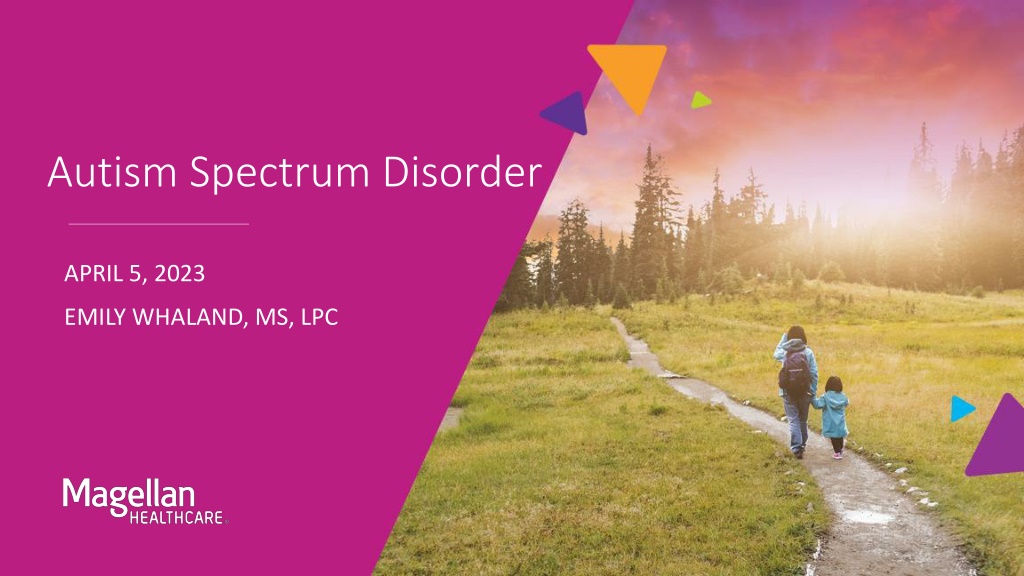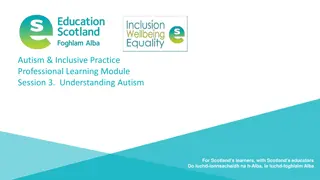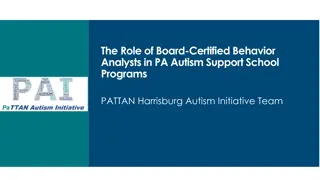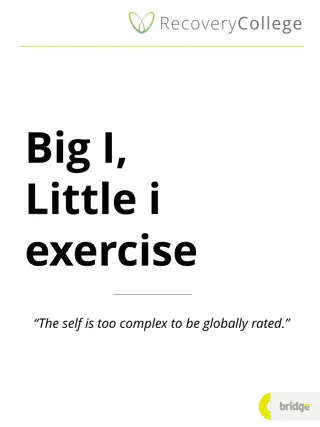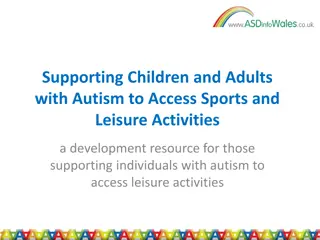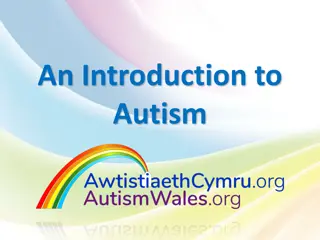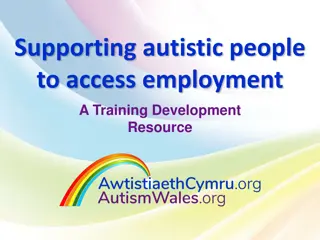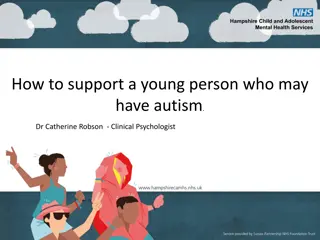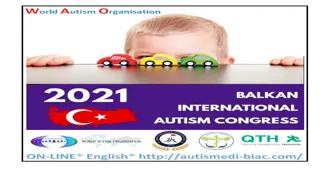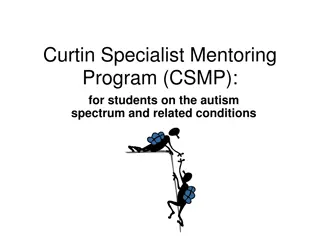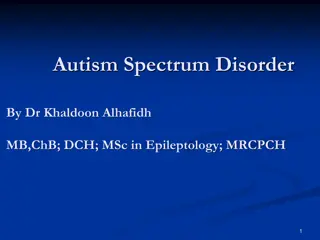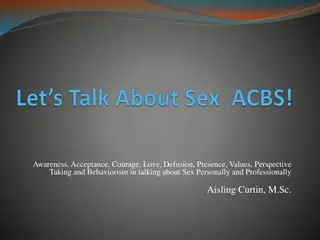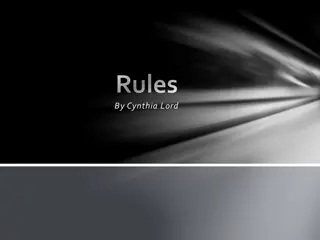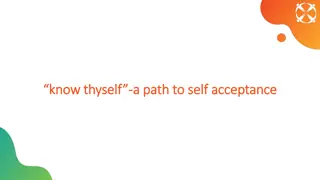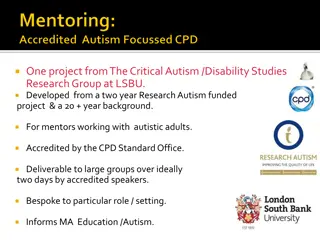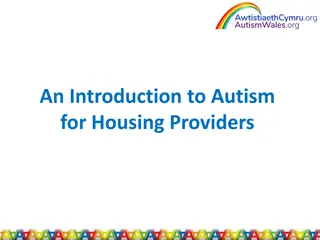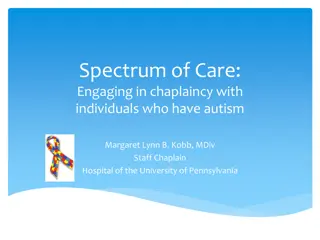Autism Acceptance vs. Awareness & Why It Matters
Trainings led by Emily Whaland, LPC, highlight the shift from awareness to acceptance in understanding autism. The sessions focus on fostering diversity, enhancing transition planning, and empowering autistic voices. Rejecting stigma and stereotypes, the agenda encourages active involvement and support to create an inclusive environment. An insightful exploration of the impact of language choices and promoting neurodiversity through acceptance over awareness is discussed.
Download Presentation

Please find below an Image/Link to download the presentation.
The content on the website is provided AS IS for your information and personal use only. It may not be sold, licensed, or shared on other websites without obtaining consent from the author.If you encounter any issues during the download, it is possible that the publisher has removed the file from their server.
You are allowed to download the files provided on this website for personal or commercial use, subject to the condition that they are used lawfully. All files are the property of their respective owners.
The content on the website is provided AS IS for your information and personal use only. It may not be sold, licensed, or shared on other websites without obtaining consent from the author.
E N D
Presentation Transcript
Autism Spectrum Disorder APRIL 5, 2023 EMILY WHALAND, MS, LPC 1
Trainings in Review 2020: Understanding Autism and a review of the CDC and AAP Clinical Guidelines 2021: Fostering Autism diversity and an enhanced look at transition planning and collaboration of care 2022: Autism and the Clinical Practice Guidelines 2023: Accepting, Honoring & Empowering Autistic Voices 2
Agenda Autism Acceptance Versus Awareness Refresher & Why It Matters Challenging Stigma and Stereotypes- Honoring and Accepting Autistic Voices Next Steps to Get Involved & Show Support 3
Acceptance Versus Awareness & Why It Matters
Acceptance versus Awareness Awareness: Acceptance: the quality or state of being accepted or acceptable, the act of accepting something or someone: the fact of being accepted: approval MW dictionary the quality or state of being aware: knowledge and understanding that something is happening or exists - MW dictionary Disease based language implying a cure needs to be found to resolve the condition and/or symptomology is seen as a weakness Understanding and welcoming based language to create an inclusive environment Autistic driven approach to creating opportunities for advocacy and action to destigmatize and break down societal barriers Allows for stereotyping, fear, and pointing out differences in a negative light 5
Acceptance versus Awareness I wish to live in a world where acceptance is not just the goal, but the reality. I want to live in a world where someone talking in the deficit model of awareness is regarded as uncomfortably out of touch with how things should be. This is my world too, and I want it to be filled with people who know that I am autistic and fantastic, not that I have autism and that is tragic. In my ideal world, flapping will be just as acceptable as smiling, earplugs will be a normal sight, AAC devices will be common and everyone will know how to converse with AAC users. In that world, neurodiversity will be just another way that people are unique, and everyone will agree that diversity is part of what makes the world so beautiful. - Kassiane S. (ASAN) Read More Below: Acceptance vs. Awareness - Autistic Self Advocacy Network (autisticadvocacy.org) Acceptance is an Action: ASAN Statement on 10th Anniversary of AAM - Autistic Self Advocacy Network (autisticadvocacy.org) 6
Autism Awareness knowing autistic people exist. Autistic Acceptance accepting autistic people as they are, strengths and weaknesses. Autistic Pride Autistic people feeling safe & confident enough to have pride in their authentic neurodivergent selves #WorldAutismDay -LYRIC HOLMANS OF THE NEURODIVERGENT REBEL
Moving from awareness, which is often used in discourses on disease and illness, towards acceptance, which is more positive, will help to destigmatize the condition and enable autistic people to speak about our condition on our terms. -SARINAH O DONOGHUE
Creating awareness was the first step in our conversation about disability inclusion, however, acceptance enforces awareness and reflects how our society should celebrate the differences and abilities that neurodivergent people have. -ELLE LOVE
Acceptance versus Awareness Awareness Acceptance How can neurotypical individuals get involved to support neurodiversity? Autism Spectrum Disorder Action Connection Advocacy 10
Challenging Stigmas & Stereotypes ACCEPTING & HONORING AUTISTIC VOICES
Challenging Stigma and Stereotypes How do you define Autism? When you hear the word Autism what comes to your mind? What comes to mind when you think of the cause, the cure , and the treatment of Autism? How have you seen Autism portrayed in the media? Are people with Autism either a genius, rude with no empathy, or just non- verbal and non-social? What if someone doesn t look or act autistic? Who has Autism?
Challenging Stigmas & Stereotypes TED-Ed Weekend: What it s really like to have Autism as presented by Ethan Lisi https://www.ted.com/talks/ethan_lisi_what_it_s_really_like_to_have_autism?language=en 13
Hearing & Honoring Autistic Voices A few things I picked up on were But the question is, am I really diseased if I just think differently? The main problem with living autistic in today s society is that the world just isn t built for us. Some people think, because of our ability to mask, that this is the cure for autism. However, all it really do is makes us ashamed of showing our true selves. Whether it be receiving an awesome birthday gift or listening to a tragic story on the news, I cannot really express my reply without bursting, so once again, I have to mask it in order to appear normal. My inner feelings are unlimited, but my mind only lets me express extremes or nothing. 14
Challenging Stigma and Stereotypes Seek media created and/or performed by Autistic/Neurodiverse individuals As We See It Hannah Gadsby s Douglas The Reason I Jump Love on the Spectrum Autism is a different way of thinking, moving, communicating, socializing, processing senses, and doing day to day activities. Autism looks different ways. Some people may need help, others may not. No one cause of Autism, no cure for Autism, no one size fits all treatment for Autism. Anyone can be diagnosed with Autism, at any age. Women can mask more based on societal norms, causing men to be diagnosed more. Learn what masking is and how it impacts Autistic individuals. What is visible on the outside may be drastically different than what s going on inside Look outside symptom buckets and labels. Shift perspective from the Linear Spectrum to the Pie Chart/Wheel Spectrum
The Autism Wheel vs the Linear Spectrum Wheel 1: Wheel 2: From Autistic Linear Spectrum to Pie Chart Spectrum | Psychology Today & Why the Autism Wheel is replacing the 16 16 Spectrum - AbleLight Blog
Challenging Stigmas & Stereotypes TEDx Austin College: Behind the Mask: Autism for Women and Girls as presented by Kate Khale https://www.youtube.com/watch?v=Tbes1mm2VgM 17
Hearing & Honoring Autistic Voices A few things I picked up on were Neurotypical people might think that autistic people are insecure or manipulative for trying to hide our symptoms. This isn t true. The real reason an autistic person would mask is because of a natural human desire to fit in and connect with others and achieve social and professional success Think about this, when you re having a conversation with somebody you are doing a lot of things at once. You have the correct posture, you re the right distance away from them, you re using the right facial expressions, you re modulating your tone, you might be gesturing, you re making the right amount of eye contact, you re not not looking them in the eyes but you re not looking them in the eyes so much that it s creepy and you re predicting what the other person is going to say or do next. For the neurotypical people all these things come naturally, and you guys don t need to think about them but for me I have to think about all those things at once. 18
The Next Steps to Get Involved & Show Support
Get Involved & Show Support Awareness Acceptance Unconditional acceptance of Autism Learn about Neurodiversity and educate yourself Connect with Autistic Individuals Identify yourself as an Autism Ally Do not use ableist language Support organizations that are run by Autistic individuals or partnered with Autistic Individuals Light it up Red , Gold , or with Color Acceptance cannot occur without Autistics Autism Spectrum Disorder Action Connection Advocacy 20
This Graphic Shows What the Autism Spectrum Really Looks Like (themighty.com) 21
Confidentiality statement The information presented in this presentation is confidential and expected to be used solely in support of the delivery of services to Magellan members. By receipt of this presentation, each recipient agrees that the information contained herein will be kept confidential and that the information will not be photocopied, reproduced, or distributed to or disclosed to others at any time without the prior written consent of Magellan Health, Inc., a subsidiary of Centene Corporation. The information contained in this presentation is intended for educational purposes only and should not be considered legal advice. Recipients are encouraged to obtain legal guidance from their own legal advisors. 23
